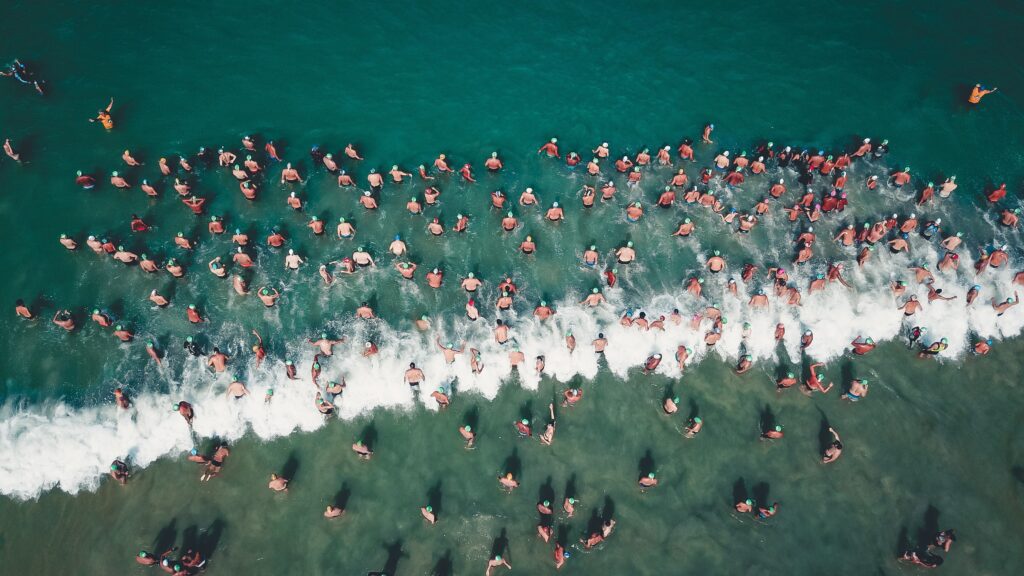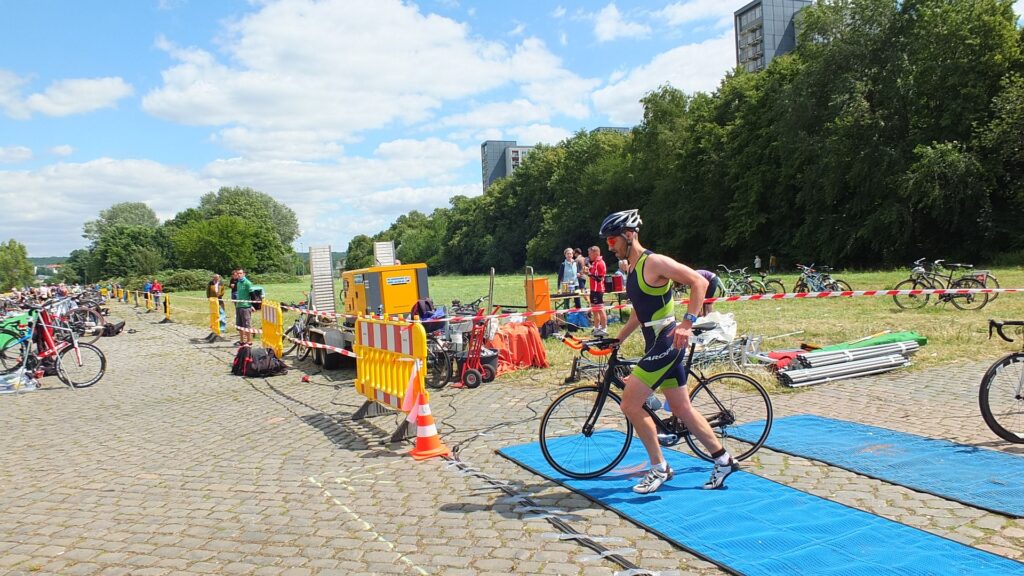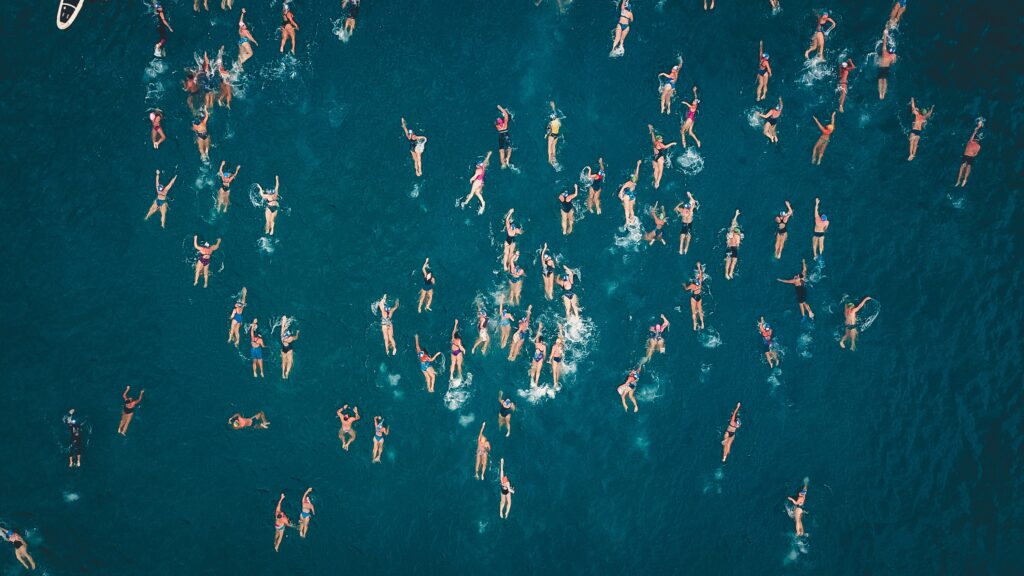What is the order of a triathlon?
How does a triathlon work? What order are the three sports done in? Read on to learn more about the order of a triathlon.
What is a triathlon?
A triathlon is a multisport endurance event that consists of swimming, cycling, and running. The three disciplines are completed back to back, with athletes transitioning between events as quickly as possible. A standard triathlon always has the same order: the swim is first, then the cycle, and finally the run. The various reasons for this order are outlined below. There are also multiple distances available in triathlon which are explained here.
The origins of triathlon
Triathlon is a fairly modern sport, originating in France in the 1920s. The first event was held in Joinville-le-Pont and consisted of a 3km run, a 12km bike, and a swim across the river Marne. However, it did not start to become popular until the 1970s, after a race organized by the San Diego Track Club. Similarly to the triathlon in France, this race began with a 3-mile run, then a 5-mile bike, before a swim around the bay. These events used the reverse format of the triathlon order we know today.
A few years after this, the first Ironman Triathlon was held in Hawaii, after an argument about which of the three disciplines was the most challenging. Hawaii was home to three events that were combined to create the Ironman Triathlon. These were the Waikiki Rough Water Swim (2.4 miles), the Around-Oahu Bike Race (112 miles), and the Honolulu Marathon (26.2 miles). This event established the swim-bike-run order of triathlons.
Triathlon Order
Swim
Depending on the triathlon event, the swim is either done in a pool or in open-water. Generally, shorter events are held in a swimming pool, while longer events are held in a lake or the ocean. These longer races usually require athletes to wear wetsuits if the water is not above a certain temperature. Although they can be difficult to remove, wetsuits help a triathlete by providing warmth and buoyancy.
Some events consist of a mass start, where all of the competitors start at the same time. This will only be done in an open-water swim and can be intimidating for athletes who are not comfortable with swimming in close proximity to others. Where a mass start is not possible, participants start one at a time or in groups. In a pool, athletes share lanes or snake from one lane to another.

Transition 1
Once the swim is finished, triathletes must enter a transition area to prepare for the bike leg. Often referred to as T1, this area allows athletes to set up their bike on a bike rack and lay out their kit for the race. After exiting the swim, participants change into their cycling kit, grab their bike and helmet and head out on to the bike course.
Most triathletes wear a tri suit for the entire race, as it allows them to avoid changing clothes. A tri suit is a piece of clothing specifically designed for triathlon. It is quick-drying and has a thin pad to provide comfort on the bike without causing irritation during the run. For more information on what to wear during a triathlon read our guide to essential triathlon kit.
Bike
In any triathlon, the bike usually takes the most amount of time for athletes to complete. The course can be as short as 6 miles in a Super Sprint Triathlon, or as long as 112 miles in an Ironman.
The bicycle allows triathletes to carry lots of nutrition with them. Numerous water bottles and energy gels give them the energy to complete the race. At longer events, feed stations on the course allow athletes to restock their supplies during the ride.
The bike route is usually completed on paved roads, some of which may have been blocked to traffic to create a safer environment for racing. In most events, triathletes are not allowed to ‘draft’. This means you cannot ride directly behind another athlete as you gain an aerodynamic advantage.

Transition 2
After completing the bike leg, the athlete must enter the transition area and leave their bike in their designated space. They can then change into the appropriate kit for the final leg of the race. Although this is the same transition area as before, it is referred to as T2.
Run
Triathletes are usually very fatigued when they start the run. After a long time on the bike, many athletes suffer from ‘jelly legs’ that feel heavy and make it difficult to run. Insufficient fuelling during the bike leg often causes this. Feed stations on the run can help athletes try to mitigate this problem if it occurs.
The run course is often full of spectators who will cheer you on to the finish line. Most races are decided during the run in professional triathlon,. It reveals which athletes have trained most effectively for the race or paced themselves best.
Why is the triathlon Order swim-bike-run?
The swim can be dangerous
The primary reason for the order of a triathlon is safety considerations. Although deaths are not common in triathlons, a study analyzing races between 2006 and 2008 showed that the majority of deaths occurred during the swim. The researcher argued that this was partly due to the difficulty in stopping to rest properly or be noticed if you are in trouble.
Swim when you are fresh
If the swim was not the first leg of a triathlon, athletes would be more fatigued, which would exacerbate these problems. Furthermore, many athletes come to triathlon from a running or cycling background. For many triathletes, swimming is their weakest discipline, so they are more likely to have problems during the swim. The swim is held first to minimize the risk of drowning, as participants are fresh and alert at the start of the race.

Fatigue on the bike
The bike is the second leg for similar reasons. As participants often ride at high speeds, crashes can cause serious injuries. An athlete is more likely to crash if they are physically or mentally fatigued, so the bike leg must come second. Furthermore, if the bike was the final leg of the race, the finish would become more dangerous. Triathletes often sprint for the finish line to beat a certain time or a fellow competitor. Allowing a sprint finish on bikes would pose a risk to athletes and spectators.
The run must come last
As the swim must come first and the bike second, the run must be the third event. If you are extremely fatigued, it is easier to stop during the running leg. It is also easier for medical assistance to help you. Finishing the race with a run also allows friends and family to cheer you on and share the moment of crossing the finish line with you. The swim-bike-run format is the perfect order of a triathlon.
Alternatives to triathlon
A triathlon is not the only choice if you want to compete in multisport events. There are numerous other race types that combine different disciplines.
- Duathlon: Run - Bike - Run
- Aquathlon: Swim - Run
- Aquabike: Swim - Bike
- Cross Triathlon: Swim - Mountain Bike - Trail Run
- Cross Duathlon: Mountain Bike - Trail Run
- Swimrun: Swim - Run - Swim - Run - Swim - Run
- Winter Triathlon: Run - Mountain Bike - Cross-Country Skiing
As you can see there are loads of multisport events that you can enjoy if you want to branch out from triathlon. Don’t enjoy swimming? Sign up for a duathlon. Want to explore more rugged landscapes? Enter a cross triathlon. Entering a different event can help make your triathlon training more varied and enjoyable.
Training for a triathlon
Training for a triathlon requires a bit more effort than training for a single sport. You need to balance your training across three sports and include some strength training to prevent injuries. If you’re just starting to get into triathlon, check out our guide to training for your first triathlon. The order of a triathlon changes the way you need to train for a race. Completing ‘brick sessions’ is important to get used to running after a tough bike ride. These involve doing a run immediately after a bike workout, in effect stacking disciplines on top of each other like bricks. If the triathlon order was different, the training requirements would also change.
Email: contact@smarttriathlete.com